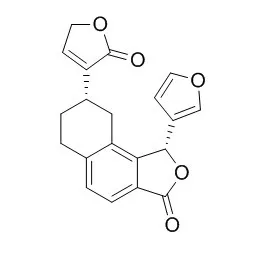| Animal Research: |
| Drug development research, 2019. | | Antidiarrheal, vasorelaxant, and neuropharmacological actions of the diterpene tilifodiolide.[Reference: WebLink] | Salvia tiliifolia is used in folk medicine as a relaxant agent and for the treatment of diarrhea and neurodegenerative diseases. Tilifodiolide (TFD) is a diterpene obtained from this plant. The purpose of this work was to evaluate the antidiarrheal, vasorelaxant, and neuropharmacological actions of TFD. These effects were selected based on the folk medicinal use of S. tiliifolia.
METHODS AND RESULTS:
The antidiarrheal activity of 1–50 mg/kg p.o. TFD was assessed with the castor oil related tests. The vasorelaxant effect of TFD (0.9–298 μM) was performed with smooth muscle tissues from rats, and its mechanism of action was evaluated using different inhibitors. The sedative, anxiolytic, and antidepressant effects of 1–100 mg/kg TFD were assessed. The possible mechanisms of action of the anxiolytic and antidepressant effects of TFD were evaluated using inhibitors. TFD exhibited antidiarrheal (ED50 = 10.62 mg/kg) and vasorelaxant (EC50 = 48 ± 3.51 μM) effects. The coadministration of TFD with N(ω)-nitro-L arginine methyl ester (L-NAME) or 1H-[1,2,4] oxadiazolo[4,3-a]quinoxalin-1-one (ODQ), reverted the vasorelaxant action showed by TFD alone. TFD exerted anxiolytic actions (ED50 = 20 mg/kg) in the cylinder exploratory test, whereas TFD (50 mg/kg) showed antidepressant actions in the tail suspension test by 44%. The pretreatment with 2 mg/kg flumazenil partially reverted the anxiolytic actions of TFD, whereas the pretreatment with 1 mg/kg yohimbine abolished the antidepressant effects of TFD.
CONCLUSIONS:
In summary, TFD exerted antidiarrheal activity by decreasing the intestinal fluid accumulation and vasorelaxant effects mediated by nitric oxide and cyclic guanosine monophosphate. TFD showed anxiolytic and antidepressant effects by the partial involvement of gamma-Aminobutyric acid (GABA) receptors and the possible participation of α2-adrenoreceptors, respectively. |
|
| Structure Identification: |
| Helvetica Chimica Acta, 2004, 87(4). | | Novel Diterpenoids from Salvia dugesii.[Reference: WebLink] |
METHODS AND RESULTS:
Two novel rearranged clerodane diterpenoids, dugesin A (1) and dugesin B (2), were isolated from the aerial parts of Salvia dugesii, together with five known clerodane diterpenoids: isosalvipuberulin (3), salvipuberulin (4), Tilifodiolide (5), salvifolin (6), and salvifaricin (7). Their structures were elucidated on the basis of different spectroscopic techniques.
CONCLUSIONS:
The isolation and identification of these compounds are significant from both biosynthetisis and chemotaxonomy points of view. |
|






 Cell. 2018 Jan 11;172(1-2):249-261.e12. doi: 10.1016/j.cell.2017.12.019.IF=36.216(2019)
Cell. 2018 Jan 11;172(1-2):249-261.e12. doi: 10.1016/j.cell.2017.12.019.IF=36.216(2019) Cell Metab. 2020 Mar 3;31(3):534-548.e5. doi: 10.1016/j.cmet.2020.01.002.IF=22.415(2019)
Cell Metab. 2020 Mar 3;31(3):534-548.e5. doi: 10.1016/j.cmet.2020.01.002.IF=22.415(2019) Mol Cell. 2017 Nov 16;68(4):673-685.e6. doi: 10.1016/j.molcel.2017.10.022.IF=14.548(2019)
Mol Cell. 2017 Nov 16;68(4):673-685.e6. doi: 10.1016/j.molcel.2017.10.022.IF=14.548(2019)